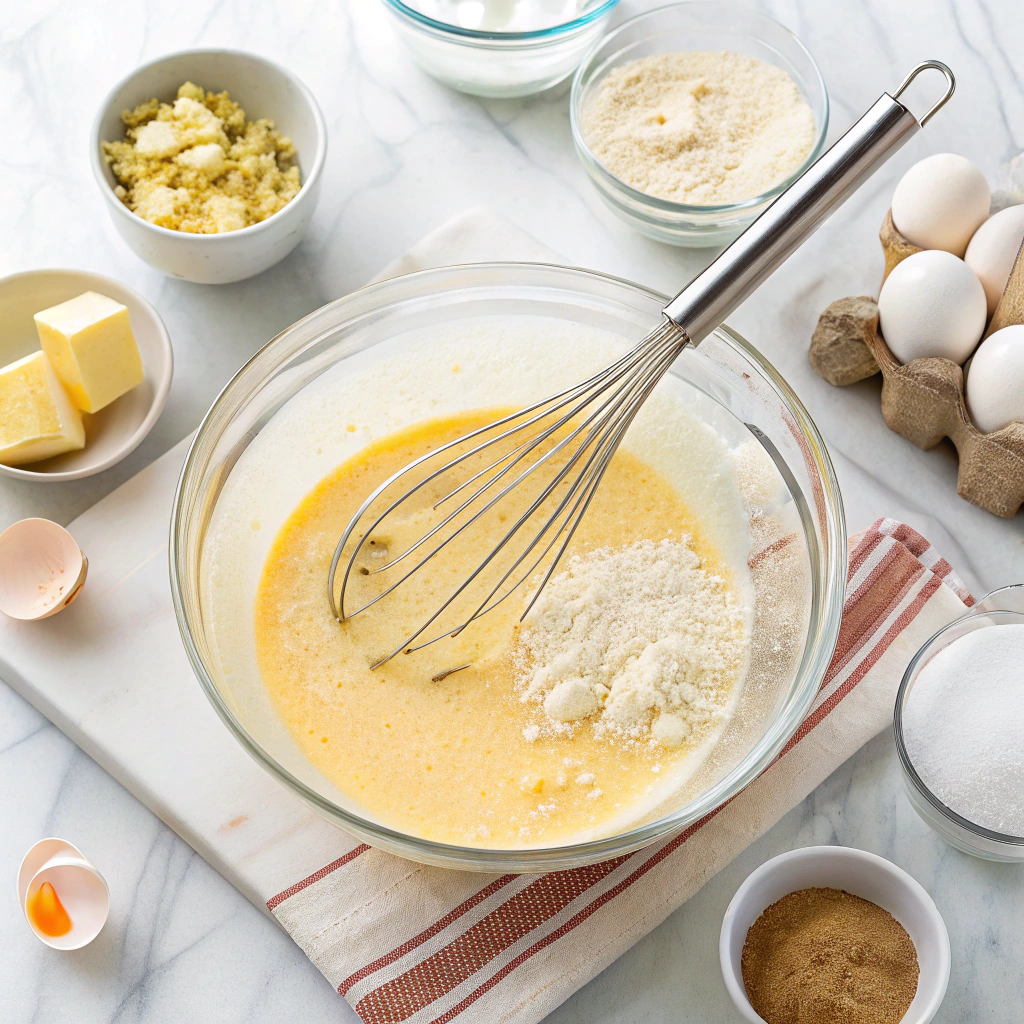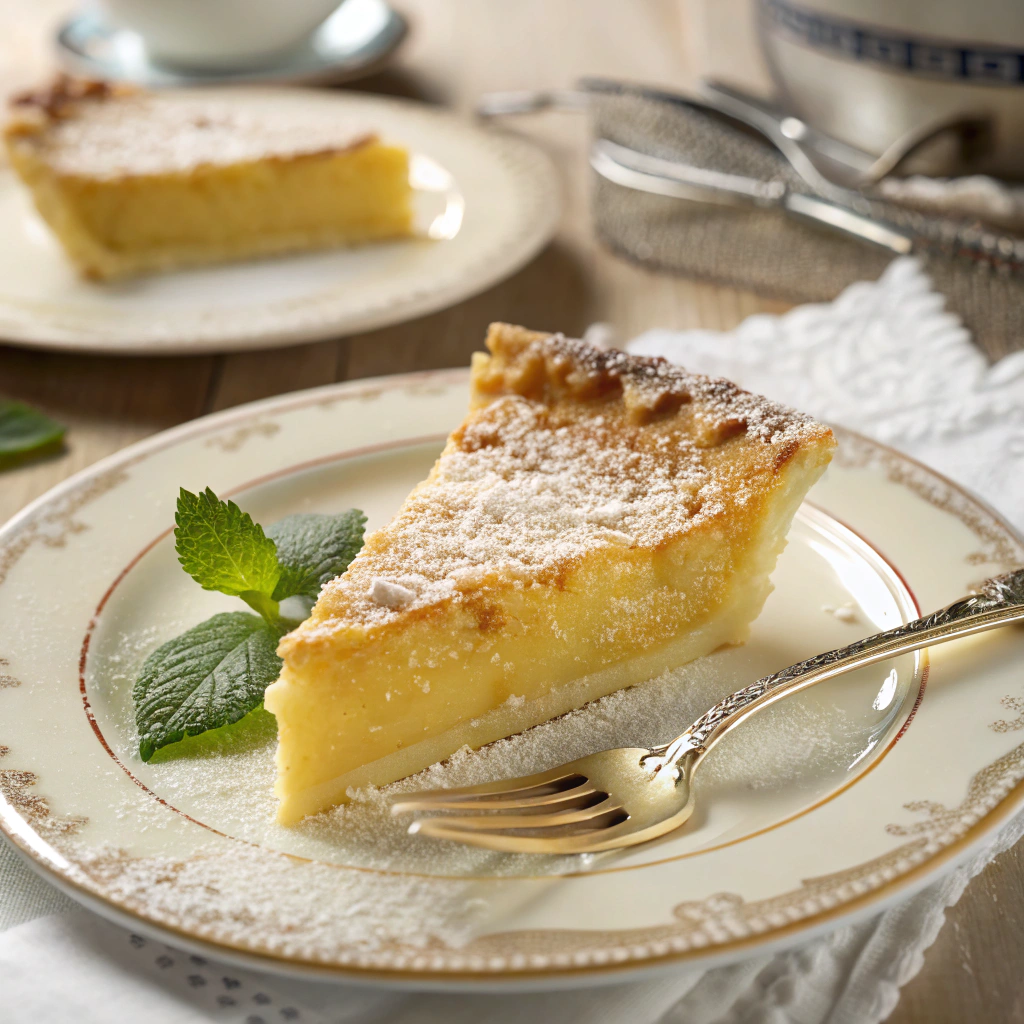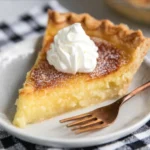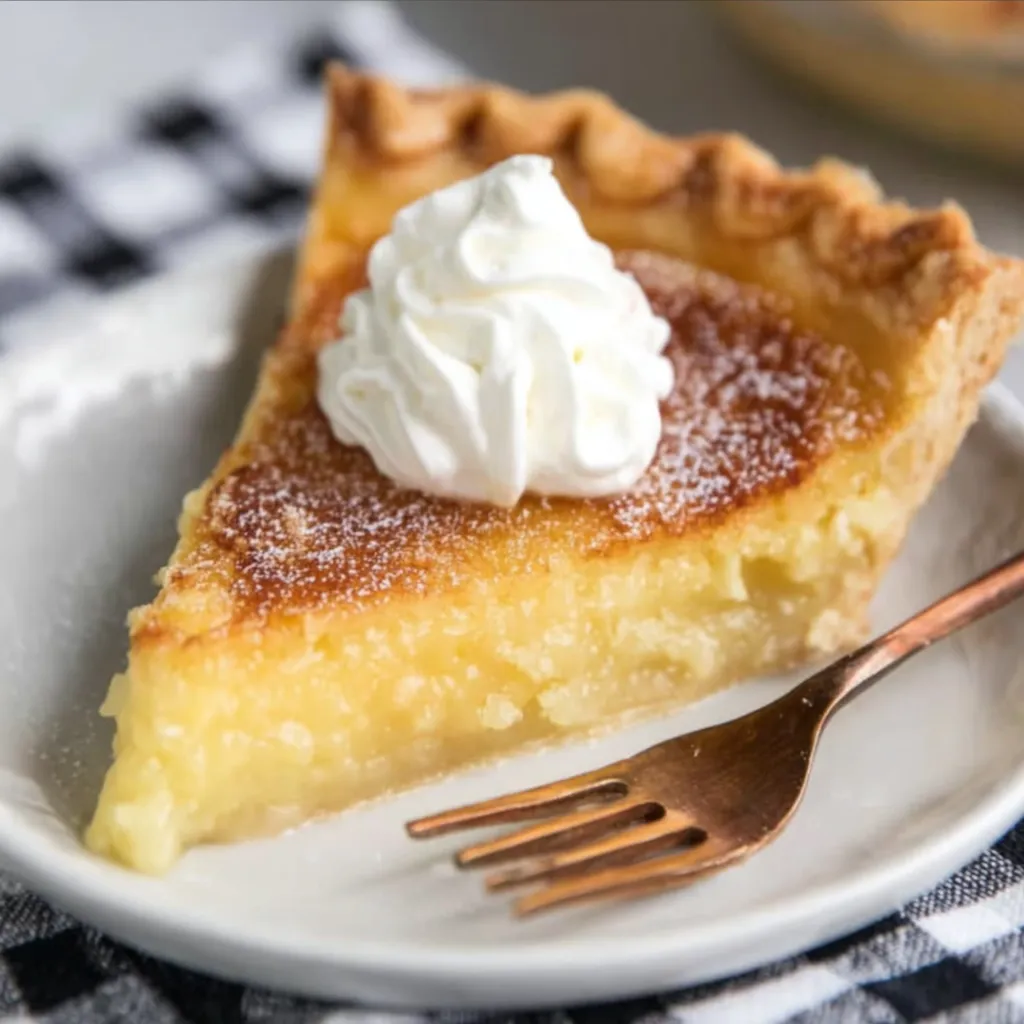This classic chess pie recipe represents the pinnacle of Southern baking simplicity – transforming basic pantry staples into an extraordinarily rich, custardy dessert that has graced family tables for generations. Much like other beloved Southern dessert variations, this timeless treat showcases how humble ingredients can create something truly magical when combined with proper technique and Southern tradition.
Many home bakers struggle with achieving the perfect custard consistency, preventing cracks, and understanding the unique role of cornmeal in this classic chess pie recipe. The difference between a perfectly set, silky custard and a disappointing, curdled mess often comes down to understanding temperature control, mixing techniques, and timing. These challenges have left countless bakers frustrated, wondering why their chess pie doesn’t match the restaurant-quality versions they remember from childhood.
Today, you’ll master the complete technique for creating restaurant-quality chess pie with foolproof methods for perfect texture every time. This comprehensive guide addresses every aspect of chess pie preparation, from ingredient selection to troubleshooting common problems, ensuring your Southern custard pie becomes a family favorite that rivals any traditional bakery.
Table of Contents
What Makes Chess Pie Special: Understanding the Classic Southern Dessert
Chess pie holds a treasured place in Southern culinary heritage, with its origins deeply rooted in resourcefulness and tradition. This Chess Pie Origins and Historical Context reveals how this dessert emerged from the necessity of creating something special from common household ingredients during times when exotic supplies were scarce.
Historical Origins and Regional Significance
The true origins of chess pie remain delightfully mysterious, with several theories competing for authenticity. Some food historians suggest the name comes from “chest pie,” referring to how these pies could be stored safely in a pie chest without refrigeration. Others believe it derives from “cheese pie,” as early versions sometimes included a small amount of cheese. Regardless of its etymology, this chess pie recipe has become synonymous with Southern hospitality and family gatherings.
Regional variations across the South showcase local preferences and available ingredients. Kentucky chess pie often features a touch of vanilla extract, while Georgia versions might include lemon zest. These adaptations demonstrate how the basic chess pie recipe serves as a foundation for creative expression while maintaining its essential character.
The Role of Cornmeal in Texture Development
Cornmeal distinguishes authentic chess pie from other custard-based desserts, providing the characteristic slightly grainy texture that defines this Southern classic. Unlike smooth custard pies, cornmeal creates tiny pockets of texture that give chess pie its distinctive mouthfeel. The cornmeal also acts as a stabilizer, helping prevent the custard from becoming too loose while adding a subtle corn flavor that complements the rich egg and butter base.
When properly incorporated, cornmeal distributes evenly throughout the filling, creating consistent texture without grittiness. This ingredient transforms a simple custard into something uniquely Southern, setting chess pie apart from its European custard pie cousins.
Differences From Other Custard Pies
Chess pie differs significantly from other custard-based desserts in both ingredients and technique. While traditional custard pies rely primarily on eggs, milk, and sugar, chess pie incorporates cornmeal and often vinegar or lemon juice for tang. The texture remains firmer than traditional custard, yet creamier than set puddings, creating a perfect balance that has made this chess pie recipe beloved for generations.

Essential Chess Pie Recipe Ingredients and Smart Substitutions
Success with any chess pie recipe begins with understanding each ingredient’s specific function and selecting quality components that work harmoniously together. Every element serves a purpose in creating the perfect custard texture and balanced flavor profile.
Core Ingredient Functions and Quality Selection
Fresh eggs provide the protein structure essential for proper custard formation in this chess pie recipe. Use large eggs at room temperature for optimal mixing and consistent results. The egg yolks contribute richness and color, while whites provide structure and stability during baking.
Unsalted butter allows for better flavor control and prevents excessive saltiness. Quality butter makes a noticeable difference in both taste and texture. Fine cornmeal creates the signature texture without overwhelming grittiness – avoid coarse varieties that can create unpleasant mouthfeel.
Granulated sugar not only sweetens but also tenderizes the custard and helps achieve proper browning. Pure vanilla extract adds depth and complements the corn flavor beautifully. A small amount of white vinegar or fresh lemon juice provides subtle tang that balances the richness.
Successful Substitution Options for Dietary Needs
For gluten-free versions, ensure your cornmeal is certified gluten-free and use a gluten-free pie crust. The filling naturally contains no wheat flour, making adaptation straightforward for celiac diets.
Plant-based butter substitutes work well in this chess pie recipe, though the flavor may be slightly different. Choose brands with similar fat content to dairy butter for best results. For egg substitutions, commercial egg replacers designed for baking provide better results than simple substitutes like applesauce or flax eggs, as the custard structure depends heavily on egg proteins.
Coconut sugar can replace granulated sugar, though it will create a slightly different flavor profile and darker color. The sweetness level remains comparable, making it an excellent option for those avoiding refined sugars.
Ingredient Temperature Importance
Temperature control throughout preparation significantly impacts the final chess pie quality. Room temperature eggs incorporate more easily and create smoother custard. Cold butter should be melted and cooled slightly before adding to prevent cooking the eggs prematurely.
All liquid ingredients should reach similar temperatures before combining to prevent curdling or uneven mixing. This attention to temperature details separates professional results from amateur attempts.
Step-by-Step Chess Pie Recipe with Professional Techniques
Mastering this chess pie recipe requires understanding both basic techniques and professional refinements that ensure consistent, bakery-quality results every time you bake.
Crust Preparation and Blind Baking Mastery
Begin with a standard 9-inch pie crust, either homemade or high-quality store-bought. Roll the dough evenly and place it in your pie pan without stretching, which can cause shrinkage during baking. Trim edges to leave a 1-inch overhang, then fold under and crimp decoratively.
For optimal results, blind bake the crust partially before adding the chess pie filling. Line the crust with parchment paper or aluminum foil, fill with pie weights or dried beans, and bake at 425°F for 12-15 minutes. Remove weights and lining, then bake an additional 5 minutes until the bottom appears set but not browned.
This technique prevents soggy bottoms and ensures the crust maintains its texture even with the liquid custard filling. Allow the crust to cool while preparing the filling.
Chess Pie Recipe Filling Mixing Order and Technique
Proper mixing order prevents lumps and ensures smooth custard texture. In a large mixing bowl, whisk together sugar and cornmeal first, breaking up any cornmeal clumps. Add melted, cooled butter and mix thoroughly.
Beat eggs lightly in a separate bowl, then gradually add them to the sugar mixture, whisking constantly to prevent curdling. Add vanilla extract and vinegar or lemon juice, whisking until completely smooth. Strain the mixture through a fine-mesh sieve to remove any remaining lumps or pieces of cooked egg.
The finished filling should appear smooth and pale yellow with a consistency similar to heavy cream. If lumps remain, whisk vigorously or strain again before proceeding.
Baking Temperature Control and Timing
Preheat your oven to 350°F and position the rack in the center position. Pour the filling into the prepared crust, filling to about 3/4 full to prevent overflow during baking.
Bake for 45-55 minutes, checking for doneness by gently shaking the pan. The center should jiggle slightly but not appear liquid, while the edges should be set and lightly golden. The top may develop a beautiful golden-brown color with slight puffing.
If the edges brown too quickly, cover them with aluminum foil strips. Avoid overbaking, which can cause cracking and curdling. The internal temperature should reach 160°F when measured with an instant-read thermometer.
Allow the chess pie to cool completely at room temperature before refrigerating. This gradual cooling prevents cracking and allows the custard to set properly. Like other unique dessert recipes, chess pie actually improves in flavor after resting overnight.
Troubleshooting Common Chess Pie Recipe Problems
Even experienced bakers occasionally encounter issues with chess pie preparation. Understanding common problems and their solutions ensures consistently successful results with every attempt.
Preventing and Fixing Cracks
Cracks in chess pie typically result from temperature shock or overbaking. To prevent cracking, avoid opening the oven door during the first 40 minutes of baking, which can cause temperature fluctuations. Gradual cooling also prevents surface tension that leads to cracks.
If your chess pie develops small cracks, they’re purely cosmetic and don’t affect taste or texture. For serious cracks that expose the interior, consider turning the pie into individual servings or covering with whipped cream for presentation.
Rapid temperature changes cause the most severe cracking. Always cool chess pie gradually at room temperature before refrigerating, and never place a hot pie directly into cold storage.
Achieving Perfect Custard Consistency
Proper custard texture in chess pie requires balancing eggs, liquid, and temperature. Runny custard usually indicates underbaking or too much liquid in the recipe. Ensure accurate measurements and bake until the center barely jiggles.
Curdled or grainy texture often results from temperature issues during mixing or baking. Always use room temperature eggs and avoid adding hot butter directly to the egg mixture. If curdling occurs during mixing, strain the filling before baking.
Dense, rubbery texture suggests overbaking or too many eggs. Follow timing guidelines carefully and test for doneness using the gentle shake method rather than relying solely on visual cues.
Crust Issues and Solutions
Soggy bottom crusts plague many chess pie attempts. Combat this by blind baking the crust as described, ensuring your oven temperature is accurate, and avoiding overly wet fillings. A properly baked crust should sound hollow when tapped gently.
Shrinking crusts result from overworking the dough or stretching during placement. Handle pie dough minimally and allow it to rest in the refrigerator before rolling and shaping.
Burnt edges can be prevented by covering them with foil strips if browning occurs too quickly. Monitor the pie during the final stages of baking and adjust protection as needed.
Serving, Storage, and Flavor Variations
Perfect chess pie execution extends beyond baking to proper serving techniques, optimal storage methods, and creative variations that honor tradition while exploring new possibilities.
Optimal Serving Temperature and Presentation
Chess pie tastes best when served slightly chilled or at room temperature. Remove from refrigeration 15-30 minutes before serving to allow flavors to develop fully. The custard should feel firm but not cold when cut.
For elegant presentation, dust lightly with powdered sugar just before serving. Clean, straight cuts require a sharp knife warmed briefly in hot water and wiped clean between slices. Consider garnishing individual slices with fresh berries or a dollop of whipped cream.
Traditional serving accompaniments include strong black tea or coffee, which complement the rich, sweet custard beautifully. The contrast between bitter beverages and sweet pie creates a perfect balance.
Proper Storage Techniques for Maximum Freshness
Store chess pie covered in the refrigerator for up to 5 days. Plastic wrap directly on the surface prevents skin formation, while aluminum foil maintains crust texture. Avoid strong-smelling foods nearby, as custard readily absorbs odors.
For longer storage, chess pie freezes well for up to 3 months when properly wrapped. Freeze in individual slices for convenient serving, or wrap the entire pie in multiple layers of plastic wrap followed by aluminum foil.
Thaw frozen chess pie overnight in the refrigerator rather than at room temperature to maintain texture and prevent condensation issues. You’ll find detailed Chess Pie Variations and Storage Tips that expand on these preservation methods.
Classic Flavor Variations and Seasonal Adaptations
While traditional chess pie stands perfect on its own, subtle variations can create exciting seasonal alternatives. Lemon chess pie incorporates fresh lemon juice and zest for bright citrus notes perfect for spring and summer gatherings.
Chocolate chess pie adds cocoa powder for rich, fudgy results that satisfy chocolate lovers while maintaining the characteristic chess pie texture. Coconut chess pie includes shredded coconut for tropical flair and additional texture interest.
Seasonal adaptations might include pumpkin spice chess pie for autumn, incorporating warm spices like cinnamon and nutmeg. Orange zest creates wonderful winter versions that pair beautifully with holiday meals.
Frequently Asked Questions About Chess Pie Recipe
Why is cornmeal essential in authentic chess pie recipe?
Cornmeal provides the signature slightly grainy texture that distinguishes chess pie from smooth custard pies. It acts as both a textural element and a stabilizer, preventing the custard from becoming too loose while adding subtle corn flavor. Without cornmeal, the dessert becomes a different type of custard pie entirely, lacking the characteristic mouthfeel that defines traditional chess pie.
How do you know when chess pie filling is perfectly set?
Perfect chess pie doneness shows a center that jiggles slightly when gently shaken, similar to set gelatin. The edges should appear firm and lightly golden, while the surface may show slight puffing and golden-brown color. An instant-read thermometer should register 160°F in the center. Avoid the knife test, which can create cracks and doesn’t provide accurate results for custard-based pies.
Can you make chess pie recipe ahead of time for special occasions?
Chess pie actually improves when made 1-2 days ahead, allowing flavors to meld and the custard to set completely. Store covered in the refrigerator and remove 15-30 minutes before serving to reach optimal temperature. The pie can be frozen for up to 3 months, making it perfect for advance preparation during busy holiday seasons.
What’s the difference between chess pie and buttermilk pie?
Chess pie uses cornmeal for texture and often includes vinegar or lemon juice for tang, while buttermilk pie relies on cultured buttermilk for both flavor and acidity. Chess pie has a slightly grainier texture due to cornmeal, whereas buttermilk pie remains smoother. Both represent Southern traditions but achieve different flavor profiles and textures through their distinct ingredient combinations.
How do you prevent chess pie from cracking during baking?
Prevent cracking by maintaining consistent oven temperature, avoiding door opening during the first 40 minutes, and cooling gradually at room temperature. Overbaking causes most cracks, so test for doneness using the gentle shake method. Proper ingredient temperatures during mixing also prevent issues that can lead to surface tension and cracking during baking.
What are the best toppings and accompaniments for chess pie?
Traditional accompaniments include light dustings of powdered sugar, fresh berries, or small dollops of unsweetened whipped cream. Strong coffee or black tea provide excellent beverage pairings that complement the rich sweetness. For special occasions, consider vanilla bean whipped cream or a drizzle of fruit coulis for elegant presentation while respecting the pie’s classic character.

Mastering Your Chess Pie Recipe Journey
This classic chess pie recipe represents more than just a dessert – it connects us to generations of Southern bakers who understood that simple ingredients, when treated with respect and proper technique, create extraordinary results. Chess pie mastery requires understanding ingredient roles, temperature control, and timing, but the rewards justify every careful step in the process.
Perfect custard texture comes from respecting each element’s function and maintaining consistent techniques throughout preparation and baking. From properly incorporating cornmeal to achieving the ideal doneness, every detail contributes to the final result that will grace your family table with pride.
This versatile dessert adapts beautifully to personal preferences and dietary needs while maintaining its essential character. Whether you choose traditional preparation or explore creative variations, chess pie offers endless possibilities for expressing Southern hospitality and culinary heritage. Like other creative flavor combinations, chess pie encourages experimentation while respecting traditional foundations.
Take confidence in these proven techniques and begin your chess pie journey today. Share your results with family and friends, creating new memories around this timeless Southern classic that has brought people together for generations. Your kitchen will soon fill with the irresistible aroma of success, and your reputation as a skilled baker will grow with every perfectly golden, custardy slice.
Print
Classic Southern Chess Pie
- Total Time: 1 hour 30 minutes (plus 2 hours cooling)
- Yield: 8 servings 1x
- Diet: Vegetarian
Description
Experience the pure magic of Southern tradition with this absolutely divine Classic Chess Pie that’s been winning hearts for generations! This legendary custard pie combines simple pantry ingredients into something truly extraordinary—a silky, sweet filling with the most heavenly texture thanks to a secret touch of cornmeal. With its golden, caramelized top and custardy center that’s perfectly balanced with bright lemon, this is comfort food at its finest. Perfect for family gatherings, church potlucks, or anytime you want to create something that tastes like pure Southern hospitality!
Ingredients
- 1 unbaked pie crust (store-bought or homemade 9-inch)
- 1 stick (8 tablespoons) unsalted butter, melted
- 2 cups granulated sugar
- 4 large eggs, at room temperature
- 3 tablespoons yellow cornmeal
- 1 tablespoon all-purpose flour
- ¼ cup whole milk, at room temperature
- 1½ tablespoons fresh lemon juice
- 1 teaspoon pure vanilla extract
- Pinch of salt
- Powdered sugar for dusting (optional)
Instructions
- Prep Your Pie Foundation: Preheat oven to 375°F (190°C). Roll pie crust into a 12-inch circle on a lightly floured surface, then transfer to a 9-inch pie plate (no deeper than 1¼ inches). Tuck edges under and crimp beautifully. Freeze for 20 minutes to prevent shrinkage.
- Blind Bake to Perfection: Prick the frozen crust bottom 8-10 times with a fork. Line with parchment paper, fill with pie weights, and place on a rimmed baking sheet. Bake 10-12 minutes until edges are dry.
- Finish the Crust: Carefully remove parchment and weights. Return to oven and bake 3-5 minutes more until bottom is dry and edges are light golden brown. Cool slightly, then reduce oven temperature to 350°F (175°C).
- Create the Legendary Filling: In a medium bowl, whisk melted butter and sugar until smooth and glossy. Add eggs one at a time, whisking well after each addition to create that perfect custard base.
- Add the Classic Touch: Whisk in cornmeal and flour until just combined—this gives chess pie its signature texture! Then add milk, fresh lemon juice, vanilla, and salt, mixing until the filling is silky smooth.
- Bake to Golden Glory: Pour filling into the prepared crust and bake 45-50 minutes until edges and center are completely set. If the crust or surface browns too quickly, tent with foil during the last 15 minutes.
- Cool and Serve with Pride: Let pie cool completely for about 2 hours—this allows the custard to set to perfection. Dust with powdered sugar before serving for that beautiful finishing touch that makes every slice special!
Notes
The secret to perfect chess pie is patience—let it cool completely for the ideal custard texture! The cornmeal is what distinguishes chess pie from other custard pies, giving it that characteristic slightly grainy texture that’s absolutely delicious. Room temperature eggs and milk blend more smoothly for the silkiest filling. Fresh lemon juice is essential for that bright flavor that balances the rich sweetness. This pie actually improves with time—it’s even better the next day! Store covered in the refrigerator for up to 4 days. Serve at room temperature for the best flavor and texture.
- Prep Time: 30 minutes
- Cook Time: 1 hour
- Category: Dessert
- Method: Baking
- Cuisine: Southern American
Nutrition
- Serving Size: 1 slice (1/8 of pie)
- Calories: 485
- Sugar: 54g
- Sodium: 295mg
- Fat: 20g
- Saturated Fat: 11g
- Unsaturated Fat: 9g
- Trans Fat: 0g
- Carbohydrates: 75g
- Fiber: 1g
- Protein: 7g
- Cholesterol: 135mg

